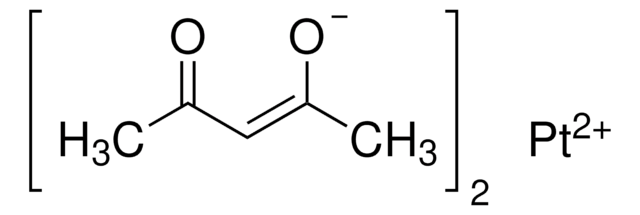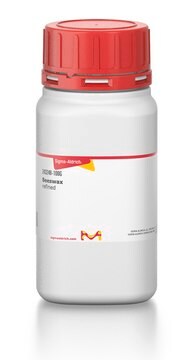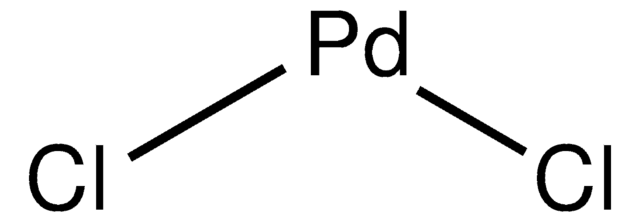262587
Chloroplatinic acid solution
8 wt. % in H2O
Synonyme(s) :
Hexachloroplatinic acid solution, Hydrogen hexachloroplatinate(IV) solution, Platinic chloride solution, Platinum(IV) chloride solution
About This Item
Produits recommandés
Forme
liquid
Niveau de qualité
Pertinence de la réaction
core: platinum
reagent type: catalyst
Concentration
8 wt. % in H2O
Densité
1.05 g/mL at 25 °C
Chaîne SMILES
Cl.Cl.Cl[Pt](Cl)(Cl)Cl
InChI
1S/6ClH.Pt/h6*1H;/q;;;;;;+4/p-4
Clé InChI
GBFHNZZOZWQQPA-UHFFFAOYSA-J
Vous recherchez des produits similaires ? Visite Guide de comparaison des produits
Description générale
Chloroplatinic acid solution catalyses the hydrosilylation reaction of 1-Hexyne to form l,6-Bis(trichlorosilyl)hexane.
Application
- Platinum precursor in the synthesis of platinum nanoparticles using hydrazine as a reducing agent.
- An electrolyte in the preparation of various carbon-supported platinum nanomaterials with H2SO4 by electrodeposition method in the presence or absence of organic additives.
- An anionic precursor in the preparation of Pt/SBA_BEA catalyst for the hydro isomerization of n-hexadecane.
- A Pt precursor in the preparation of PVP-protected Pt-nanoparticles by seed-mediated growth method.
Mention d'avertissement
Danger
Mentions de danger
Classification des risques
Acute Tox. 3 Oral - Aquatic Chronic 2 - Eye Dam. 1 - Met. Corr. 1 - Resp. Sens. 1 - Skin Corr. 1B - Skin Sens. 1 - STOT RE 2
Organes cibles
Kidney
Code de la classe de stockage
6.1B - Non-combustible acute toxic Cat. 1 and 2 / very toxic hazardous materials
Classe de danger pour l'eau (WGK)
WGK 3
Point d'éclair (°F)
Not applicable
Point d'éclair (°C)
Not applicable
Équipement de protection individuelle
Faceshields, Gloves, Goggles, type ABEK (EN14387) respirator filter
Faites votre choix parmi les versions les plus récentes :
Déjà en possession de ce produit ?
Retrouvez la documentation relative aux produits que vous avez récemment achetés dans la Bibliothèque de documents.
Les clients ont également consulté
Articles
Noble-metal nanostructures are widely used in a variety of applications ranging from catalysis to electronics, surface plasmon resonance (SPR), surface-enhanced Raman scattering (SERS), and biomedical research.
Contenu apparenté
Generic QA Testing Page
Notre équipe de scientifiques dispose d'une expérience dans tous les secteurs de la recherche, notamment en sciences de la vie, science des matériaux, synthèse chimique, chromatographie, analyse et dans de nombreux autres domaines..
Contacter notre Service technique










